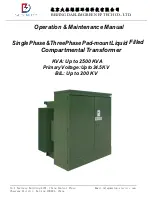
SECTION 3 - TROUBLESHOOTING
3.1 Symptom / Resolution Chart
SYMPTOM
TO RULE OUT
RESOLUTION
Circuit Overload
Measure the amperage in the low-voltage side of the
transformer to determine if exceeding transformer power
rating. Remove loads if necessary. See chart in section
entitled ”Specifications” for model’s output current in
amps.
Defective Wiring
Check wiring to load. Improperly insulated wiring or
moisture in the wiring can cause the thermal safety to
cycle.
Taps Connected
Together
Determine if the unused taps are connected together on
multi-tap units. If they are wired together, the transformer
will make a loud buzzing noise and turn off very quickly.
If left unattended, the lead wires can melt. Insulate any
unused wiretaps individually with wire nuts.
Lights cycle off / on every 10 to 20
minutes
Insufficient
Ventilation of
Transformer
If the transformer has improper ventilation, the
transformer will become hot and the thermal safety
overload will trip.
Transformer is buzzing
Taps Connected
Together
Determine if the unused taps are connected together on
multi-tap units. If they are wired together, the transformer
will make a loud buzzing noise and turn off very quickly.
If left unattended, the lead wires can melt. Insulate any
unused wiretaps individually with wire nuts.
Confirm
transformer shuts
off in less than 10
minute intervals
This is not a problem with the transformer. It is an
indication of a load issue and equipment connected to
transformer will need to be checked.
Failed Light
Sensor
There may be a problem with the load, e.g. a bad sensor
in the light fixture. Only the manufacturer of the light
fixture can address this problem.
Lights cycle off / on every few
seconds
Failed Low Water
Sensor
It may be an indication that the low-water cut-off sensor
in the light fixture is bad. Only the manufacturer of the
light fixture can address this problem.
The transformer is putting out
voltage, but the lamp isn’t working
Outside Wiring
If the transformer is working and the lamp isn't lighting,
the problem is not with the transformer. Check for the
integrity of wiring to the load or the load itself.
The transformer is working fine, but
it is warm to the touch
Insufficient
Ventilation of
Transformer
A transformer under full load will be warm to the touch
and the surface temperature can reach 130° F. This is
normal. If the transformer has improper ventilation, the
transformer will become hot and the thermal safety
overload will trip.
Wrong Meter
Setting Used
If there is full voltage going to the transformer it should
be producing a full 12-volt output. Ensure the output
voltage is being measured with a voltmeter set on the AC
voltage setting - not the DC setting.
An electrical meter shows only
two (2) volts output from the
transformer
Incorrect Usage of
Transformer
It is a common misconception that transformers
change
AC-voltage to DC-voltage. A Transformer only
reduces
voltage. As an example, the Safety Volt transformer can
reduce 120-volts AC to 12-volts AC, 13-volts AC, or 14-
volts AC.
Figure 7

























